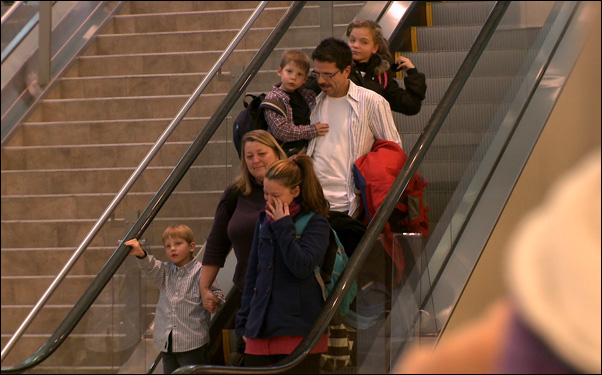Having last attended the Toronto International Film Festival with “The Sound of Mumbai,” an inspiring documentary about a group of kids from the slums of India who came together to sing the songs of the Von Trapp family in a one-night performance of “The Sound of Music,” there’s no wonder filmmaker Sarah McCarthy was intrigued with the work of Dr. Robert Marvin, a professor emeritus at the University of Virginia School of Medicine. An expert in attachment theory (of why one person bonds to another psychologically), Dr. Marvin created a therapy program that specializes in families created out of adoption, allowing both parents and children to learn how to love one another.
Intrigued by the program, McCarthy headed to Wisconsin to meet Claudio and Cheryl Diaz, a couple who always envisioned a family of six, though a series of miscarriages made it biologically impossible after their first daughter Cami was born. More children are the only thing missing from what Claudio describes as a “Disney family,” a nod to the fact he worked for much of his life at the Magic Kingdom, and with Cami in her teens preparing to leave the nest, the Diaz clan travel to the far less happy place of Arkhangelsk, Russia to begin the process of adopting the 11-year-old girl Masha, and five-year-old twin brothers Marcel and Vadim to bring them back to the States.
From State Orphanage No. 7 to the American Midwest, McCarthy and her crew embedded themselves for a year-and-a-half with the Diaz family to make “The Dark Matter of Love,” capturing an astonishing transformation that’s not without its rocky times. The boisterous nature of the two boys has Claudio wondering what the family has done even before they get off the plane in the U.S. while the seemingly reserved Masha causes problems for her new sister Cami, whose openness to new siblings begins to wane as she gets less attention from her parents.
Aided by Dr. Marvin’s involvement, the film is able to place the Diazes struggles in a greater context of how we form meaningful relationships, but since filming ended, “The Dark Matter of Love” has entered into a larger context as well. The Diaz family turned out to be one of the last American families to bring children over from Russia after President Vladimir Putin put a ban on the practice earlier this year, a move that left 300 children that were already set to new homes in limbo. As a result, McCarthy not only has something rare on her hands, but a film that could genuinely affect change and when we spoke at TIFF this week, she spoke with excitement about the impact the film is already making, how she got interested in the subject and how she became an older sibling in the Diaz household.

It’s kind of a weird story. I was at the Natural History Museum and there was this amazing installation made by a friend of mine. It was very simple – it was just a mirror and there were pictures of a sad chimp, a happy chimp, a surprised chimp, and an angry chimp. The deal was you were supposed to arrange your facial features in a way that reflect the monkeys’ facial expressions. You do that, then you go through the whole Darwin Exhibition, and you come to the end and you realize that the mirror that you made your monkey face into is a two-way mirror and there’s an ante-chamber full of people, mainly kids, pointing and laughing at your ridiculous monkey faces.
I just thought that was such a smart way of depicting a difference between us and monkeys and it made me think about emotions in terms of evolution. Like what is the survival value of an emotion or what is [its] biological function? Also, when you go back around, you walk past that twoway mirror again, you now know that there are people watching you, so I thought that’s what separates us from the apes – the ability to be self-aware about our emotions. So I became very, very interested in the science of parent-child love and just got lost in the field for about six months of research, which was a terrible financial decision, but I just was so, so interested in doing a film on it.
Through that research, I came to Bob Marvin, who has just the most extraordinary program. The basis of it is he tries to work with adoptive parents to understand why their adopted children are behaving the way that they’re behaving; and to help the parents try and build on some of the healthy parenting habits that they’ve inherited from their parents and also to work on some of the unhealthy habits that they’ve inherited as well. It’s not just adoptive families that can learn from that, it’s everyone who’s been parents. Parents, no matter how good they are, will always fuck you up a little bit, right? [laughs]
Bob tries to educate people about what the scientifically proven elements of a healthy parent-child relationship are and then help people understand why that behave the way that they behave in love relationships.

Definitely, because when the family first came together, all those relationships were thrown up in the air. Because we were in the mix, when they were settled, they settled including us. The family was under such stress taking on those three kids, it put a real strain on Claudio and Cheryl’s marriage and on Cami’s relationships with her parents. They sort of stopped talking to each other because Cami knew that her parents wanted the family to work for her and Claudio and Cheryl were under such physical and mental strain everyday that they were forgetting to be husband and wife.
It was my job to talk to them about their feelings for hours a day. I can’t help but when people are revealing intimate details of their lives, I do the same thing. We became fast friends and I felt for a while like, especially in Russia when Bob and Nicole [the other psychologist] weren’t there, I was their proxy because I knew a little bit about what they were doing and I tried to think, what would Bob do in this situation? I was sort of playing a kind of counselor role in Russia and when we got back, I just slotted into the oldest sibling in the family and my cameraman did as well. We lived across the street from them, all day, everyday for weeks and weeks and weeks. We even had five shoots over the course of 18 months, varying in length from two weeks to six weeks.
This was filmed before Russia dramatically changed their adoption policy involving the U.S., but was permission to film them tricky to get?
We had a really good fixer. Permissions were relatively easy and that should be much harder now. My cameraman is a conspiracy theorist and he’s convinced that there were people following us but I just don’t know whether to believe him or not because he likes the idea that he’s living in a spy novel. I didn’t know how true it was, but there were a couple of people in our party who you certainly got the sense were observing us.
The more difficult run-in that we’ve had with the Russian Government was we screened [the finished film] at the OSCE Parliamentary Assembly in Istanbul [with] the Russian delegation, 56 Parliaments, 7 delegations and 10 or 12 Senators and members of congress to this thing. The Russian delegation were working really hard to try and block the screening in any way that they could. They deleted the movie file from the shared drive with the OSCE and they allocated us a room that was miles away from the actual conference center so no one could find it. We managed to circumvent all of these obstacles to screen, which was great.
The other thing is we approached some paralympians who had been adopted from Russia to the US to join our campaign. We’re kind of working to use the film to raise the profile of 300 kids who had met their U.S. parents and not yet been able to complete their adoptions. Soon after we approached these guys, the Russian Government basically threatened to withhold their visas for the Sochi Olympics. It was extraordinary that they would have the resources to be keeping an eye on all of this.

When I was shooting the film I had no political ambition for it at all. I just wanted to tell a beautiful story with some scientific truth within that. But as soon as President Putin banned adoption in January, I just felt compelled because I just lived this adoption story and saw what a difference a family can make to kids’ lives [that I wanted to make my film available to] use in any way that I could because I love Mash, Marcel and Vadim. They’re such brilliant little kids and the idea that those guys need a family, then be promised a mom and dad, which is all that these kids want in these orphanages, for that to be taken away is just abhorrent.
We just only just started maneuvering and selling the film, but it’s played at Capitol Hill, and at Moscow Film Festival, we’re broadcasting in Russia later this year. But the whole situation is so dire. We just had Jessica Veselica, [one of the women whose adopted child was stuck in the pipeline] come out [to our Toronto premiere] and [another] one of the kids who was stuck was adopted in to Canada. This gave some of the other parents the idea that maybe if we’re not going to be able to get our kids out, maybe we can get them into Canada, so I’ve been helping them connect with Canadian press. A couple of the stories have actually sparked Canadian families to come forward, willing to start the quite dangerous process because it’s entirely possible that they’ll invest tons of emotion and time, and money. They’re still bravely taking those first few steps to register paperwork. Which is incredible, just incredible.
“The Dark Matter of Love” does not yet have U.S. distribution. It will show once more at the Toronto Film Festival on September 13th at the Scotiabank 3.




